40 years of alternative programming at WCBN-FM
No monkey business was tolerated in the prehistoric era of student radio at U-M.
The old Campus Broadcasting Network of the 1950s and ’60s was a placid, public-service-y operation that broadcast Glee Club concerts and football games. The signal went only by wire to dorm rooms, and the rules might have been written by a sorority house mother.
The early-’60s staff manual warned the on-air talent to “refrain from ‘editorializing’ about the practices, procedures, or services of the University, unless the comment is in a positive vein … especially in dealing with the University food service,” and “any statement over the air that [was], in any way, profane, obscene, indecent, or suggestive” was “grounds for immediate dismissal.” It was even considered “in bad taste to play records at the wrong speed for the sake of novelty.”
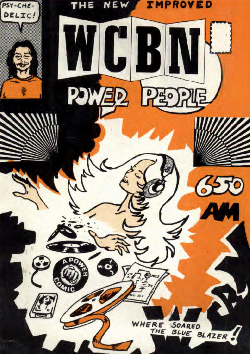
This homespun WCBN comic book captures the essence of college radio in the ’70s. (Comic book courtesy of Tavi Fulkerson.)
Any remnant of that regime was gone for good on Jan. 23, 1972, when WCBN-FM went on the air—a real, over-the-airwaves radio station broadcasting at 10 ambitious watts around the clock all week long. A campus raised on the rock revolution now had its own student deejays competing for the student ear. They eagerly took on not only the staid format of classical music and news at WUOM, the official “voice of the University of Michigan,” but every pop-schlock station from Detroit to Toledo to Kalamazoo.
They made the most of it. Studios in the basement of the Student Activities Building were renovated and re-equipped in 1973, and the station began to broadcast in stereo. Inside its little listening area, a serious alternative to Top 40 radio was on the rise. (An AM counterpart, WRCN, kept broadcasting to the dorms with a format of strictly “’60s Gold.”)
From the start, WCBN took itself seriously as the music aficionado’s alternative to commercial rock radio. “What radio stations have to do more than almost anything else is to teach,” said Mark Lloyd, a program director of the early ’70s. “If you get to the point where you’re just throwing junk out there for people to listen to over and over and over again, you’re not teaching anybody anything.” A writer for the underground Ann Arbor Sun praised WCBN’s “abiding appreciation for the intelligence and adventurousness of Ann Arbor listeners.”
A listener who kept the radio tuned to CBN around the clock heard a little of practically everything. (The station, originally broadcast left of the dial at 89.5-FM, now lives even further left at 88.3-FM.)
In 1974, for instance, the morning music block bowed to mass taste with light rock and country—the Eagles and the Doobie Brothers. After lunch the sound shifted to progressive rock—Pink Floyd or Emerson, Lake, and Palmer. In the evening the big block was rhythm and blues. After midnight came modern jazz. In “free-form” blocks, the mix was jarringly eclectic, shifting from an Elvis oldie to “Hello, Dolly!” to Beethoven’s “Ninth.” Between the music, one heard not the robotic talk machines of commercial radio but real students—irreverent, quirky, occasionally sophomoric, and seldom observant of the earlier standards of good taste. Yet high culture also found a home on CBN.
“You are not in any way restricted to music on vinyl,” read a mid-’70s training manual. “Spoken word and other non-musical material provides some of the most pleasant radio experiences possible. Think of your own experiences as a listener. The miracles of magnetic tape, live performances, poetry, and text-sound combinations—the entire sound-world is at your disposal.”
The station gave plenty of air time to fervent talk about public affairs. “I remember playing antiwar songs as a music bed while Greg Bowman and Lee Van Ameyde read the draft lottery numbers off the UPI ticker,” wrote Ron Humenny in a recent collection assembled by WCBN alums to commemorate the 40th anniversary of the station’s shift to commercial air. Today Humenny is owner of the Starfire Companies, a tax planning and investment management firm.
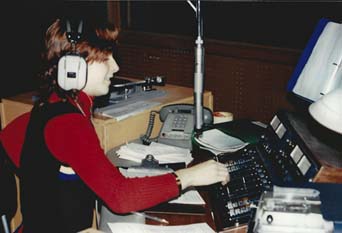
Student deejay Tavi Fulkerson recalls hanging out with John Sinclair shortly after he was released from prison. “He liked jazz like I did,” she says. Today, Fulkerson runs her own marketing firm, the Fulkerson Group. (Image courtesy of Tavi Fulkerson.)
Early programming included a show called “Black Edition,” which dealt with African-American issues. “The Women’s Tour” ventured into feminism. In an era when “gay liberation” was still a radical notion, WCBN talked about it. Students across the campus voiced their opinions during “Talkback,” a phone-in show.
To the regular listener, CBN’s special charm was the frequent interruption of the utterly unpredictable. Josh Pachter, a mid-’70s deejay, related one such moment in the 40th anniversary “scrapbook.”
“I remember announcing one night that I was going to light what was either a bomb or a smoke pot at midnight in order to find out what it was,” said Pachter, who now teaches at Northern Virginia Community College and the University of Maryland. “Come midnight, I flicked a lighter next to the mic, put on a sound-effect record of a nuclear explosion, shut down the transmitter and left.”
Humenny also reflected on the staff’s youthful—and basically harmless—form of anti-establishment rebellion. “We would sign on the station in the middle of the night before there was an overnight show—just because we felt like it.”
Not every memory of student radio in that era was pleasant. But even a bad memory can be put to good use.
In 1972 senior Anne Doyle parlayed her experience at WCBN into an internship across the street at WUOM. On her first day, a veteran male broadcaster stopped her at the newsroom door, pointed to a line on the floor, and said: “Do you see this line? Don’t you cross it. Don’t come in here to answer the phone, to read the news wires, or to put something on my desk. There is no place in a newsroom for a woman.”
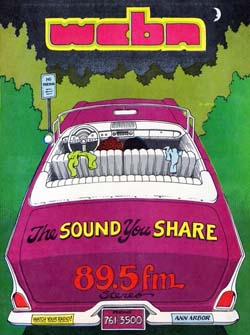
Renowned Detroit artist Gary Grimshaw created this early poster to promote WCBN. (Image courtesy of Tavi Fulkerson.)
Chagrined but unbowed, Doyle stuck it out at WUOM, and her experience there and at WCBN led to broadcasting jobs in Grand Rapids, Los Angeles, and Detroit. At WJBK-TV she covered the major Detroit teams and became the first woman in broadcasting to conduct an interview in a pro football locker room. For what she did to change the perception of women covering sports, she was named to the Michigan Journalism Hall of Fame in 2007.
Doyle was too classy to note that the man who wanted no women in newsrooms is not counted among her fellow inductees.
“The only thing I could do in 1972 was prove him wrong,” she wrote recently, “which I and thousands of other female journalists did.”
The station has remained iconoclastic in the years since it first beamed beyond campus. (When Ronald Reagan was elected president, for instance, WCBN broadcast Lesley Gore’s “It’s My Party” for 18 hours straight.) But for the founders of CBN’s FM age, the early years on the air were an unrepeatable era.
“I can’t think of what I’d change,” New York-based entrepreneur Gary Kreissman reflected in the 40th anniversary booklet. “CBN was really at the heart of what I liked about U of M.”
A collection of WCBN/WRCN records is held by U-M’s Bentley Historical Library.


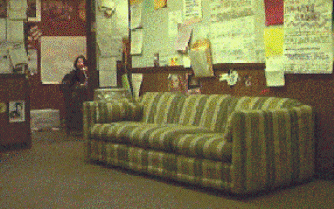
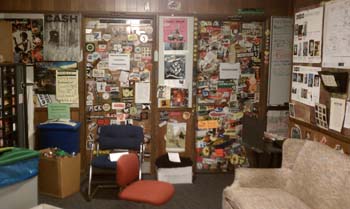


Gerald Nanninga - 1976, 1978
My time at CBN back in the mid 1970s were some of the happiest of my life. I remember being on the air when we got news that the Lynyrd Skynyrd plane went down. That photo of the couch brought back a lot of memories.
Reply
Jim Kline - 1981
Brings back fun memories. I believe I was actually a DJ on WRCN around 1979-1980, and I had a listnership of probably 12. But it was fun to be on the airwaves and do pretty much what you wanted. I had a lunch-time program and would spend the morning in Econ class writing jokes based on the news. This sort of came in handy later on when I worked as a comic for about 9 years. (I’m talking about the joke writing, not Econ). If I needed a restroom break, I would put on Alice’s Restaurant, which allowed enough time, that I could have gone on a short vacation. I remember my friend Steve Bilnitzer had a late night show, and he pretty much did whatever he pleased, in a variety of altered states. It was fun and a great experience.
Reply
Steven Stockmeyer
Participating in the early days of WCBN is one of my most favorite memories of Michigan. In my days, the studio was in the basement of South Quad. I was honored, although unprepared to be named News Director at one point which allowed me to cover all kinds of significant, national political events once I could convince the credentialing authorities that we were legit. Even though we had such titles, the operation was all volunteer and we were all jacks and jills of all trades. We used to joke that you could get reception in the dorms through your bedsprings. Occasionally the power would be mysteriously increased and one could get the signal outside of the dorms until we were the target of an investigation by the Federal Communications Commission. Great fun and great training — thanks for the story.
Reply
Jim Peters - 1973
There was classical music on WCBN for a while! I ran a department where a small staff of us broadcast classical music four evenings a week and on Sunday mornings: until rock took over the whole show. I remember coming in on cold winter Sunday mornings turning on the whole station and playing the national anthem. Thanks for reminding me of those great times.
Reply
Jocelyn Clapp Ozolins
Thank you for this story. I was at CBN in the late ’70s/early ’80s. Happy to see that the anarchic, curious spirit of CBN continues to this day. Also very happy that Arwulf is still on the air. Jocelyn Ozolins — Orient, NY
Reply
Mike Mouradian
One of the reasons I love Ann Arbor. My music education is from WCBN. Nice article.
Reply
Rick Sanok
Great story!!! I remember getting in trouble a couple of times on the air on my latenight rock and roll show. I’d play a lot of requests, wrap up at 2 a.m., and head back to all the parties that I was invited to (for playing the requests). By the time I got there, everyone would be crashed out. At the time, WCBN supported a few of us going to a conference in New York where I met Kenny Loggins.
Reply
Jay Heiser
Great headline reference to the Replacements!
Reply
Jim Manheim
We still have classical music! Check out Dead White Guys Sunday morning from 6 to 9. And, for all the iconoclasm, we’ve really served as a pretty good training ground for people who want to go into broadcasting—I’ve got a list of about 75 WCBN alums who have worked in related fields at one time or another.
Reply
Marae Price - 1978
I loved WCBN! I used to listen to it all the time when I was working at UM. I tolerated Jazz Till Noon and lived for Freeform Radio-de-o-de-o all afternoon. From CBN I learned about harmonic (“throat”) singing and won tickets to see the Clancy Brothers and Tommy Makem Reunion concert. WCBN was and will always be my favorite radio station. Thank you for the memories!
Reply
Byron Haskins - 1978
I certainly enjoyed hosting “Round Midnight” on WCBN. 415
Reply
John Wilson - 1976
That story about the line in the news room doesn’t sound right. Not for the times as I recall them.
Reply
David Saltman
As news director of WCBN during its Golden Age, 1965-1967, I’m here to tell you that your reporter would have been fired for filing the above piece. He missed the story entirely. During that period, WCBN’s news department made national headlines with its reporting on the Vietnam war, from coverage of the first teach-in to exclusive reportage on the military draft. Our radio documentaries on these topics were picked up and rebroadcast worldwide by the CBC. The programming department set the standards for what became “underground radio,” so important in the cultural history of the ’60s and early ’70s. Most importantly, WCBN was the training ground for a whole generation of media stars and standouts: Gilda Radner, original cast member of Saturday Night Live, began her career as “the weather girl” on our breakout morning program “The Saltman-Segal Psychedelicatessen.” Steve Segal, my co-host on that show, became a famous DJ on the top stations in Los Angeles and Boston. Joe Quasarano, DJ and program director, became a top media executive in LA. Justin Friedland, DJ, became Paris bureau chief for ABC News. Bill Kirchen, a regular guest on our show, became a world-famous musician, after a long stint with our pals and frequent on-air guests, Commander Cody and the Lost Planet Airmen. Jim Mack, Vince Capizzo, Rob Marks and other technical wizards became big behind-the-scenes stars in the media. I became a producer on CBS News Sunday Morning, then executive producer of documentaries at CNN in New York. There is much more to this story.
Editor’s Reply: Thank you for your feedback, David. WCBN always has attracted and produced amazing talent. The era in the ’60s you describe sounds particularly vibrant and compelling. A story about the post-U-M careers of the station’s impressive alumni is certainly worthy of coverage. It should be noted, however, that this piece was not intended as a comprehensive historical overview of the station or its staff. This story looks at one specific event and moment in time—1972—when WCBN hit the commercial FM airwaves. It’s just one significant plot point in the expansive WCBN story. Clearly the station presents a rich vein of content we will continue to mine in the future.
Reply
Martin H. Buchman
I’m happy to see coverage of the older WCBN. Me, I was part of the very original Campus Broadcasting Network, which fascinated me during my days as a student staff member in 1953-57. I served as an announcer; dance host in South Quad; news specialist; hockey color announcer; ad salesman. Loved it! This during the days of the stringing of the first cable lines through the steam tunnels from East, West, and South Quads up to the hill… my memories are affectionate and very warm!
Reply
Jeff Hirsh - 1973
The switch from carrier current through the dorms to the big sound of 10 watts was like reaching out and discovering the world …or at least discovering Toledo. I did the Oldies show in the first days of FM, and I recall one cold clear night getting a request from Toledo. The request may have been to get off the air, I don’t recall … but reaching Toledo with our 10 little watts was like reaching the moon.
Reply
Bob Heuer - 1974
Did the news and/or sports for WCBN one night a week, during the blues show with DJ Gene ______(don’t remember his last name. He intro’d me one night, saying, “Now here’s Bob with the true blues, the news.” I chuckled on the air, and outtro’d back to him after finishing: “…and now back to Gene, with the true news, The Blues!”
Reply
Ron Humenny - 1974, 1979
Gene Hyman, perhaps?
Reply
Theresa Lafer
As a historian I am appalled by the response of your editor to David Saltman’s comments. To start an article with 3 paragraphs of what the world was like in the 60s and then say this article is only about the 70s is disingenuous at best. The 70s may well have had expanded electronics; but in fact they did not have expanded consciousness. They are worth writing about, not because they were pioneers of Broadcasting, but rather that they are part of a much longer tradition.
Reply
Mark Lafer - 1968
I was the Fine Arts director from 1965 through 1968. To paraphrase Dave Saltman’s comments (hi, Dave) – who did your reporter speak to?
Reply
Tom Simonian - 1977
My 15 years at the station (Music Director 85-90)were some of the best of my life.
Learned much more at WCBN, than class.
I will try and post a link to one of my Synthescapes shows here soon.
Freeform
Synthescapes
The 4 Minute Wait
Crush Collision
Reply
Mike Block - 1964
I was a DJ on WCBN for part of my freshman year (1960-61). I played classical music and did a little news. The most vivid thing I remember is that I announced the breaking news that Casey Stengel had been fired by the NY Yankees after the 1960 World Series.
Reply
Gerry Ahronheim - LS&A '62, Med. '66
Thanks for the story. The cockles of my heart are a bit warmer.
My small part of the prehistoric wired-to-the-dorms era was “Sunday Serenade”, with a mix of classic and more modern music (not R&R etc.) keeping things gentle and cool. It was fun, and permits me to brag that I was once a DJ. Some of my younger sibs, all Michigan alums, actually made music, though!
Reply
Bob Cope - 59, 61, 67
Was there in South Quad in 56-57….a real rookie….light music….nothing exciting happened.
Reply
Bob Cope - 59, 61, and 67
I was happily amused reading the comments of all (so far) that followed me as a host for some kind of light music at South Quad’s studio in 56-57. As I had been a DJ at a rural UP station (WJPD) before applying, I was surprised to find they (residence manager — Noffsinger,and a student manager) almost didn’t think I was up to the ‘task.’
Reply
randy kalish
I was the sports director in 1972-73, following in the footsteps of a couple of outstanding sports directors, Al Wisk and Chuck Kaiton, who have both had successful careers in broadcasting. The sports dept. allowed me to fulfill a childhood/teenage wish with no prior experience. Being at WCBN was a big part of my years at U-M.
Reply
Byron Haskins - 1978
Great to see Tom Simonian comment. The mid-70s were great days. Even met my future wife at CBN while doing the afternoon freeform drive and she doing the reggae show. Also recall getting the late Jazz artist Marion Brown into the studio for an interview when he decided to talk with me at CBN instead of someone at WUOM for an NPR Jazz Alive broadcast. Congratualtions on celebrating your milestone WCBN.
Reply
Roger Holberg
Spent many wonderful hours at WCBN in the late ’60s. Will never forget the evening we spent on the air “analyzing” the lyrics to the just-released “I Am the Walrus.” Well, that and the student who called into my show every morning to request Buffy Sainte-Marie’s “Cod’ine,” which I dutifully played while turning off the studio monitor.
Reply
Robert Linnell - 1960E
I certainly enjoyed the WCBN article, as well as the links to the WCBN history.
I was part of the earlier era, and was South Quad station manager from fall 1958 to spring 1960. During that time, the activities at the Student Activities Building (SAB) were limited to the office of the network Chairman/General Manager, the business office and ad sales, the network program director, and the production of the daily program schedule which was hand-delivered to the three studios (remember . . . no computers in those days!), and there were no broadcasts originating at that location.
The South Quad studio contained the network switcher (controlling which studio was feeding the network), the news room (with the clattering UPI teletype), and was the hub for all remote broadcasts. During those days we did occasional simultaneous “local†student government live broadcasts for each men’s quad, as well a pre-recorded broadcast to the hill dorms for the ladies. I also remember those amazing steam tunnels through which we strung what seemed like hundreds of cables.
As late as spring 1960 there were no plans for consolidating the studios, with the three studios still permanent fixtures.
Thanks for the memories.
Robert Linnell 1960E
Reply
David Burhenn - 1975
I was in the news department at WCBN for a short time in 1973-74 (until I realized that I liked writing stories more than speaking them) but well remember the youthful fervor of the staff. The classical music world was more than adequately covered by Evans Mirageas, who went on to have a distinguished career in arts administration. He is currently the Artistic Director of the Cincinnati Opera.
Reply
Bob Dark - 1980 (MA)
I was involved at CBN from 1979-85, and General Manager from 1980-82. I followed in the footsteps of Ann Rebentisch, who organized and ran the first on-air fundraiser in 1979. We stole many of our fundraiser formatics from WUOM, but while they raised less than $1 per watt of transmitter power, WCBN raised about $1000 per watt. The on-air fundraiser and benefit concert became a mainstay for the network, which was ridiculously under-funded by the University.
The 1980 “It’s My Party” marathon was orchestrated by Ken Freedman, who went on to a long and successful career in community radio at WFMU in New Jersey. There were many cool, creative, and iconoclastic people at CBN, and we did many crazy things that were more fun than you are legally allowed to have. We picked a fight with UM Broadcasting Director Hazen Schumacher, which ended when UM Vice-President Henry Johnson gave us $3000 for new carpeting. When the UM demanded student ID numbers for all jocks, we created a list with a random number generator, turned it in, and never heard back. When some disgruntled AM jocks filed a completely inaccurate complaint with the FCC, the station spent years (successfully) defending itself.
As Thom Simonian noted, CBN provided a much higher, and more realistic, level of radio education than any UM classes. (When I went through the Radio-TV-Film program in 1979-80, the equipment was from the 1930’s.) The CBN staff produced some of the most creative, interesting, and musically education programming ever broadcast. I’m proud to have been a small part of it.
Reply
Clayton Lewis
As a long time listener and supporter, I have enjoyed both the story and the comments but. . . I think there is an important story not told here and that is that this remarkable cultural treasure is only minimally supported by the university. It is run by volunteers and expenses paid by donations. I am very disappointed that the university doesn’t see the value in investing in this great program.
Reply
Tom Simonian - 1977
Good to hear from you Bob Dark (and Byron!). The Seventies (and Eighties!) were great times at WCBN.
Ok, as offered earlier, I’ve posted 3 of my SYNTHESCAPES: An Hour of Sound Pictures in the Afternoon” on my Spotify.com page.
Enjoy. Tom
Reply
Bob Dark - 1980
Tom Simonian is my wife’s hero, even though they have never met. She is amazed by my old cassette tapes of his incredible World Music radio shows, and pleased by the fact that it was Tom who trained me for a DJ slot on WCBN back in 1979. That was the start of my 28-year radio career. Thanks, Tom!
Reply
Al Smith
I also was a DJ on WCBN ca. ’66 and ’67. A story about WCBN alums who went on to noteworthy media positions would be interesting. Two names that should be added to that list include Ken Wilson, who became a play-by-play sportscaster for the Cincinnati Reds, the Seattle Supersonics, and the St. Louis Blues, as well as Jim Dulzo, a columnist for the Detroit News who was a significant part of Detroit’s jazz scene. WCBN was an incredible and valuable experience for many of us!
Reply
Kenneth Larson - 1963(?)
West Quad in 1960- 62. Great memories, DJ, morning wake-up, taking requests, but we took WJR Detroit for our news on the hour until the staff at South Quad took evening news, weather, sports. I also had an early evening slot, during which the station manager would call me on the phone to correct my simply awful tendency to end sentences with upward inflections. Did some rip-n-read news, but learned the hard way to pre-read everything. A few amazing (EE?) students put most of our equipment together, including the board (noisy pots!), and even a comp-limiter installed at South Quad. Some of our commercials were on reel-to-reel tape. Sometimes (Saturday nights after “official” hours) we had “take-network” wars (one Quad against another Quad), or played Tom Leher’s outrageous parodies, and even experimented with a little “talk radio” with a ratty patch cord. It was fun radio, but also a serious training ground for a few mostly non-broadcast students. (I credit my addiction to WCBN radio fun for one reason I left UM without a degree — the other was the computer center, but that’s another story.) Thanks for a great memory jog! All this speaking training became invaluable for what is now 39 years of preaching and teaching.
Reply
Neal McLain - 1967 MA Radio Television and Film
Photos from my years at WCBN
http://wcbn1953-1956.blogspot.com/
Reply
Kevin Stewart - 1980
After taking an intro to Radio and TV class Fall 1979, I worked part time as a newscaster at WCBN during the summer of 1980 with Bob Dark. Bob was such a nice guy and patiently taught me how to use the AP wire, how to play carts, and how to write and read the news. Great fun!
Reply
Tom Bray - 78 and 80
I started as a DJ in 1977 or 78 doing a 2-6 AM shift. Then did a 9-12 morning show, and along with Floyd Miller who also had a morning show, created a promo with a still-famous tag line: “An Entire Spectrum of Music at One Frequency”. And while it is no longer meaningful, the other one I came up with was “Any Further Left and You’d Be Watching TV”.
I was Chief Engineer when Bob Dark was the GM, and continued for several more years after Bob left. I was the CE during the “It’s My Party” marathon with Ken Freedman. I served on the Board of Directors from the early 1990’s until 2021, when my Faculty/Staff seat was filled by Victoria Alden of WISE, part of the next generation of CBN leaders.
I recorded hundreds of live music performances around town and almost all of those recordings are now at the Bentley historical Library as part of WCBN/WRCN archives.
Many, many CBN alums have gone on to careers that where either directly spawned from their time at CBN or indirectly influenced by that time.
Reply
David Milberg - 1970
Aside from being great fun, my four years at WCBN (1966-1970) were my training for a broadcasting career that still ongoing, including stints at WPAG/Ann Arbor, WLW/Cincinnati, CBS-Owned & Operated WBBM/Chicago, Executive Producer of Chicago Bears and White Sox radio play-by-play broadcasts, PBS affiliate WYCC-TV/Chicago, WLS-FM/Chicago, WSLR/Sarasota, the “Rare & Scratchy Rock ‘N Roll” radio syndicated version and podcast, and since 1988 a frequent on-air contributor/guest on WGN/Chicago From 1966 to 1970, Bruce Holberg (who went on manage and then own a string of radio stations) and I alternated on “Michigan Movin” – a folk music show on WXYZ-AM, plus in the 1968 series “Soundscope” on WXYZ-WRIF-FM. “Soundscope became the inspiration for “Rare & Scratchy Rock ‘N Roll syndicated radio and podcast series. All this while being a full-time lawyer, too.
There are numerous WCBN luminaries who should be mentioned. It was Lou Glazer’s vision and determination that got WCBN its open-air broadcast license. Al Wisk and Ken Wilson went on to do the play-by-play for multiple major league baseball, football, soccer, and hockey teams. Chuck Kaiton is the National Hockey League Hall Of Fame for his play-by-play broadcasts of the Hartford Whalers/New England Whalers/Carolina Hurricanes.
In sum, getting a degree at the University of Michigan was merely the price of admission. Working at WCBN was where I and others actually got our education.
Reply